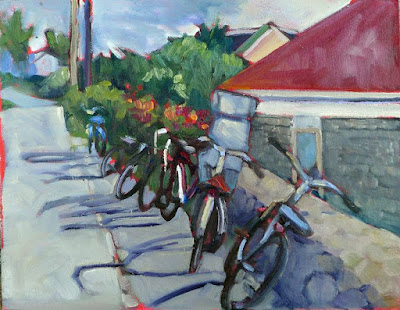Be brief, be consistent, know your stuff, and manage your own content.
 |
| Bicycles on Water Street, by Carol L. Douglas |
That little logo to the right of this post that reads “Top 75 Painting Blog” is not based on someone’s opinion. It’s based on social metrics, and I’m very flattered to be number seven on the list.
I’m frequently asked how to blog; after all, I’ve been doing it, on and off, for more than a decade. However, until a few years ago, I wasn’t getting much traction. My friend Brad VanAuken was taking my painting class. I asked him for advice. Brad is successful author, consultant and blogger, and an expert in his field, which is brand strategy.
Brad told me that random and irregular efforts are ignored in the blogosphere; I had to post on a regular schedule if I expected anyone to pay attention. Since then I have written five days a week. I keep this schedule up whether I’m in my studio or above the Arctic Circle.
That’s the same advice I give about painting. Inspiration is less important than consistent work habits. The more you practice any discipline, the better and easier it gets.
 |
| They say “write what you know.” I know painting, and not a lot else. Photo courtesy of Margaret Burdine. |
The internet reacts to pot-stirring. The more you post, the more attention you get. That’s why Instagram, Pinterest, and other social media sites matter. The good news is, you really can do them all and still have time to paint. The secret is to develop a posting protocol and follow it.
Only you can determine what social media sites works for your following. That comes from trial and error. But give them a fair shake. I regularly post on Tumblr, even though it is not my target audience. Someday, those kids will grow up.
The process takes me 90 minutes each day. If it took longer, I wouldn’t do it, because it would cut into my painting time too much.
The craft of telling a story in 400-600 words is a very specific one. It doesn’t allow for much research or for fully-realized concepts. But within it, one can convey a lot of information.
I also got excellent advice from Bob Bahr of Outdoor Painter. He said that, all other things being equal, it was best to host my own blog. That would give me control of my brand. Until then, I hadn’t realized how constrained I was writing under the flag of a daily newspaper. Since I left, my readership has risen markedly and I’m much happier.
 |
| These are the top affinity categories for my readers. I don’t tailor my writing to them. |
Art is a niche market. I write about art-specific topics, so it surprises me that visual arts and design aren’t even in the top ten affinity categories for my readers. I have never been able to predict what blog posts will capture my readers’ fancy. I generally just write about what interests me.
If you only write once a month, and your writing is strictly limited to your paintings, then perhaps it is best to send newsletters directly to your client base rather than trying to maintain a blog. Instead, use online-selling websites like Fine Art America or Saatchi Art to find new buyers.
I do not send my blog to my email marketing list. Most people read it through social media. I think the email subscription list is going the same way as the postcard. Use it, but rely more on social media.


